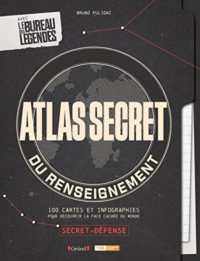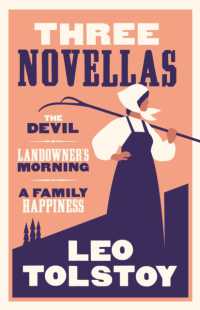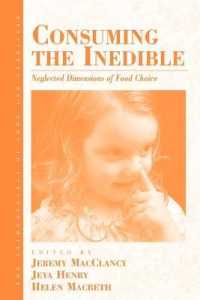- ホーム
- > 洋書
- > 英文書
- > Business / Economics
Full Description
Clean Language Interviewing is a landmark publication that defines the field for this important practice; it is essential reading for all researchers who seek to obtain data that are faithful to the experience of the interviewee. Clean language interviewing aims to improve the ability of academic and applied researchers to minimise the introduction of the interviewer's own assumptions, to avoid 'leading' questions and instead to ask 'clean' questions.
Heather Cairns-Lee, James Lawley and Paul Tosey present a state-of-the-art review of the principles and practice of clean language interviewing to make this rigorous and innovative method accessible. Using real application examples, a global group of contributors analyse the use of clean language interviewing in multiple settings including business, education, and healthcare.
Contents
PART 1
Chapter 1. An introduction to clean language interviewing for research; Paul Tosey, Heather Cairns-Lee, and James Lawley
Chapter 2. Eliciting interview data cleanly through minimising leading questions; Heather Cairns-Lee, James Lawley, and Paul Tosey
Chapter 3. Metaphor, clean language and qualitative research; Jan Nehyba
Chapter 4. Enhancing clean language interviewing with modelling; James Lawley
PART 2
Chapter 5. Exploring experiences of work-life balance: a pilot study of clean language as an interview method; Margaret Meyer, Wendy Sullivan, Paul Tosey, and James Lawley
Chapter 6. Drawing lessons learned from mental models of leadership; Heather Cairns-Lee
Chapter 7. The potential of clean language interviewing for journalists; Jacqueline Ann Surin
Chapter 8. Using clean language interviewing to explore the lived experience of neurodifferent job applicants; Nancy Doyle and Uzma Waseem
Chapter 9. Making the unspoken visible through clean language: interviews with families facing encephalopathy in their child; Tania Korsak
Chapter 10. Modelling excellence: using clean language interviewing to research exceptional performance; Lynne Cooper
Chapter 11. Coding-in-the-moment and other hidden skills of clean language interviewing; Caitlin Walker and Marian Way
Chapter 12. Facilitating change in organisations: applying clean language interviewing through action research; Maaike Nooitgedagt and Wendy Nieuwland
Chapter 13. Clean neutrality in conflict; Martin Snoddon
Chapter 14. Clean interviewing in management systems auditing; Yuji Yamagami and James Ramirez
Chapter 15. Adding value and insight: applying clean language interviewing to market research; Wendy Sullivan and Di Tunney
Chapter 16. Interviewing for cause: when interviewing is about life and death; Sharon Small
PART 3
Chapter 17. And, whereabouts is clean language interviewing now?; Paul Tosey, Heather Cairns-Lee, and James Lawley








